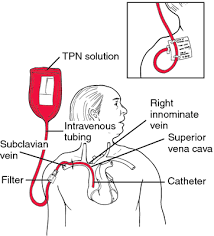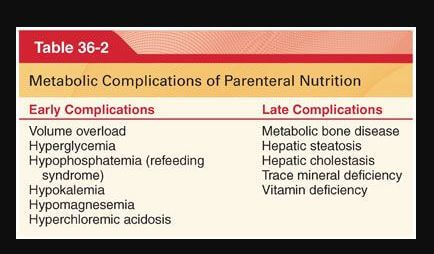What is Hyperalimentation?
Hyperalimentation is a method where vitamins and nutrients are administered to an individual in form of fluids via the vein. People who are not able to obtain nutrients from food undergo this procedure so that they can get the nutrients2.

People may have health problems that hinder them from absorbing adequate nutrients in the stomach from the food they eat. This procedure is used because an individual is unable to take nutrients through the mouth1.
Some of the health problems that may prevent a person from absorbing nutrients and vitamins from food include cancer of the gastrointestinal system such as colon cancer. Sometimes this may be as a result of treatment methods such as radiotherapy and chemotherapy.
Apart from being used to give nutrients and vitamins to people, hyperalimentation might also be used in the following circumstances:
- It may be used before the doctor performs surgery to an individual who is severely malnourished. This malnourishment may caused by birth abnormalities that cause gastrointestinal disorders such as esophageal atresia, esophageal stricture; a condition where the esophagus becomes narrow, stomach cancers or having difficulties in swallowing food.
- Hyperalimentation may also be conducted by the doctor after surgery if an individual is recovering slowly or there are complications that have arisen due to surgery. This may occur due to the following: short bowel syndrome that may cause most of a person’s small intestines to be removed; when the intestines are blocked, a condition known as ileus, which has occurred for long period of time; a painful infection of abdomen openings, a condition called peritonitis; an individual is suffering from inflammatory bowel diseases such as Crohn’s disease2.
Types
There are three forms of hyperalimentation and they include1:
Enteral hyperalimentation
This form of hyperalimentation is used when a person is suffering from serious health problems such as cancer and those with breathing stoma. In some cases, an individual may have disorders of the stomach, pharynx or esophagus, which prevents absorption of nutrients. As a result affecting enteral hyperalimentation. People who are feed via this method still have properly functioning intestinal system.
Enteral hyperalimentation can use different tubes such as gastrostomy, percutaneous endoscopic gastrostomy tubes and nasogastric. This procedure can be done on pediatric patients. In these patients, infusion pumps are used to ensure uninterrupted flow of nutrients. With the infusion pump, it may be used constantly or intermittently depending on the nutritional needs of the patient.
Enteral nutrition can also be used by patients at home. Those recommended to use it are those who are unable to swallow due to cancers affecting the stomach and neck since these tumors obstruct the digestive tract. It is also used by people with disorders of the central nervous system; they are unable to coordinate so that they chew or swallow.
Parenteral hyperalimentation
This method is prescribed for patients who have different gastrointestinal problems. It is recommended for patients who suffer from various health problems that affect nutrients from being absorbed in your intestinal tract. Parenteral hyperalimentation might also be used in patients who have undergone surgery, especially those who are malnourished.
When parental feeding is chosen, the doctor inserts a catheter (tube) into the right atrium of the patient and administers the solution. The solution might be given intermittently, the whole day or the entire night depending on the nutritional needs of the patient.
Parenteral hyperalimentation is recommended for the following gastrointestinal conditions: short bowel syndrome, Crohn’s disease, central nervous system disorders, obstruction, fistula, ileus, etc.
Intravenous hyperalimentation
This method is used for patients who are unable to swallow food via the digestive tract. The nutrients and electrolytes are given to the patients using a catheter via the vein. Intravenous hyperalimentation is used for people who are anorexics in order to re-feed them.
How is Hyperalimentation Conducted?
This procedure is customized according to the needs of each individual. The fluids given contain the following components1:
- Sugar or glucose
- Vitamins
- Amino acids
- Potassium, sodium and other electrolytes
- Fat emulsion.
Expectations
This procedure uses a pump to control the quantity of solution administered. An individual may receive it at an even rate or for some hours at night. Your doctor may also check your weight, blood sugar levels and electrolyte levels in the blood. The doctor will check the site for any infection2.
Side Effects
Hyperalimentation can cause many side effects such as:
- Sepsis- 3This condition where blood is infected. It can occur when bacteria enter the blood of the patient via the catheter.
- Thrombosis5 – The catheter placed in the vein of a patient may cause blood to clot in the veins. Blood clots can form in the lower parts of your leg or thighs or any other part of your body. It causes your leg or ankle to swell on one side and you feel pain these areas. The skin in the swollen areas may be warmer and become reddish or bluish.
- Hyponatremia4– This is a condition where sodium levels in your body is low. Sodium is responsible for controlling the quantity of water around and in the cells. Hyponatremia is caused by many factors including taking too much fluid, which dilutes sodium in the body. When this occurs, it makes cells in your body to swell.
Other side effects of hyperalimentation include1:
- The patients may experience high body temperatures (fever and chills) and have difficulties in breathing. The patient may also notice increase in the amount of urine passed out. They also feel general body weaknesses, which presents muscles cramps and twitches.
- Patients may have mental problems such as confusion or suffer from memory loss where they are not able to remember things clearly. Patients also experience reflexes that may be exaggerated. Patients also experience seizures and convulsions. They have abnormal changes in their heart beat.
- Some patients complain that they did not see clearly at night after hyperalimentation feeding. Patients may also notice changes on their skin level.
- Hyperalimentation can also cause fluid to accumulate in your body which presents other complications. It also cause mouth sores.
Hyperalimentation can be administered at home and in the hospital. Patients can choose their preferred place for this procedure. As a patient you also need to make lifestyle changes in order to minimize the risk of anxiety and depression. You need to be physically active but avoid very intense exercises. You may seek help from a physical therapist who will help determine the level of exercise for you to do.

Reference List
- http://healthh.com/hyperalimentation/
- http://www.medicineonline.com/articles/c/2/Central-Hyperalimentation/Hyperalimentation.html
- Sepsis. Available at http://www.mayoclinic.org/diseases-conditions/sepsis/symptoms-causes/dxc-20169787
- Hyponatremia. Available at http://www.mayoclinic.org/diseases-conditions/hyponatremia/basics/definition/con-20031445
- Thrombosis. Available at http://www.healthline.com/health/deep-venous-thrombosis#risk-factors2
